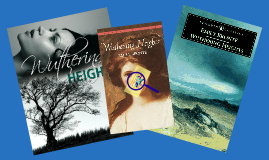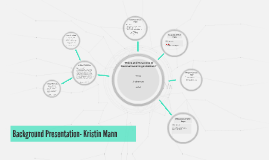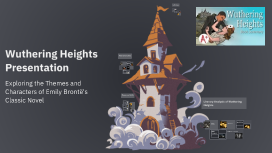Wuthering Heights Presentation
Transcript: Introduction to Wuthering Heights Author Background Emily Brontë, born in 1818, was a British novelist and poet. Wuthering Heights, her only novel, was published in 1847 under the pseudonym Ellis Bell, revealing her unique voice in a male-dominated literary world. Overview of Plot Historical Context Wuthering Heights narrates the tumultuous relationship between Heathcliff and Catherine Earnshaw. The novel unfolds through multiple narrators, revealing a tale of passion, revenge, and the lasting impacts of their choices across generations. Wuthering Heights is set in the Yorkshire moors during the late 18th and early 19th centuries, a time of social change influenced by the Industrial Revolution. This backdrop informs the characters' struggles between love and societal expectations. Significance of Title The title 'Wuthering Heights' reflects the wild, tumultuous atmosphere of the Yorkshire setting, paralleling the intense emotions of its characters. It symbolizes the duality of nature and human experience, setting the tone for the narrative. Main Characters Wuthering Heights Presentation Catherine Earnshaw Heathcliff Catherine is a fiercely passionate character torn between her loyalty to Heathcliff and her desire for societal approval. Her choices profoundly impact the lives of those around her, raising questions about love and self-identity. Heathcliff is the novel's enigmatic anti-hero, shaped by a tumultuous childhood and his obsession with Catherine. His character embodies the themes of revenge and unfulfilled love, driving many conflicts throughout the narrative. Edgar Linton Nelly Dean Edgar represents the genteel class and offers a contrast to Heathcliff. His calm demeanor and material wealth bring a sense of stability, yet he struggles with the emotional turmoil surrounding Catherine and Heathcliff. As the primary narrator, Nelly offers insight into the lives of the Earnshaws and Lintons. Her perspective shapes the reader's understanding of events, reflecting the biases and judgments prevalent in the characters' world. Hindley Earnshaw Hindley represents the destructive nature of jealousy and revenge, particularly towards Heathcliff. His ruthless behavior significantly alters the dynamics within Wuthering Heights, demonstrating the impacts of toxic relationships and familial strife. Exploring the Themes and Characters of Emily Brontë's Classic Novel Themes and Motifs Love and Passion The tumultuous love between Heathcliff and Catherine exemplifies passionate, all-consuming emotion that defies societal norms, ultimately leading to destruction and despair. Their connection is characterized by both profound yearning and deep pain, illustrating the complexity of love. Literary Analysis of Wuthering Heights Nature vs. Nurture Wuthering Heights examines the effects of environment on character development, particularly through Heathcliff's experiences of abuse and neglect. The novel poses questions about whether circumstances or inherent nature ultimately shape one's identity and morality. Revenge and Betrayal Revenge drives many characters, particularly Heathcliff, whose desire for vengeance against those who wronged him leads to tragic outcomes. Betrayal occurs frequently, notably in Catherine's marriage to Edgar, which instigates a cycle of retribution that affects multiple generations. Isolation and Loneliness Many characters in Wuthering Heights experience profound isolation, whether physically, as in Heathcliff's detachment from society, or emotionally, as with Catherine's internal struggles. This theme underscores the impact of solitude on mental and emotional well-being, shaping their destinies. Social Class and Inequality The theme of social class permeates the relationships in Wuthering Heights, influencing characters' fates and actions. Heathcliff's status as an orphan and later as a wealthy man creates tension, highlighting the rigid social hierarchies that dictate love and acceptance. Symbolism Narrative Structure Use of Setting Brontë employs rich symbolism throughout the novel, with the motifs of the weather and the landscape reflecting characters' emotions. For example, storms often accompany moments of turmoil, illustrating the connection between nature and the characters' inner lives. The novel utilizes a complex narrative framing through multiple perspectives, primarily Nelly Dean and Mr. Lockwood. This layered storytelling technique enhances the emotional depth and allows for various interpretations of characters' motivations and relationships. The settings of Wuthering Heights and Thrushcross Grange contrast starkly in both appearance and atmosphere. The wild, untamed moors symbolize freedom and passion, while the refined Grange represents order and societal norms, reflecting character dynamics. Impact on Literature Gothic Elements Wuthering Heights has profoundly influenced the landscape of English literature, introducing a new paradigm of character complexity and emotional depth. Its

















